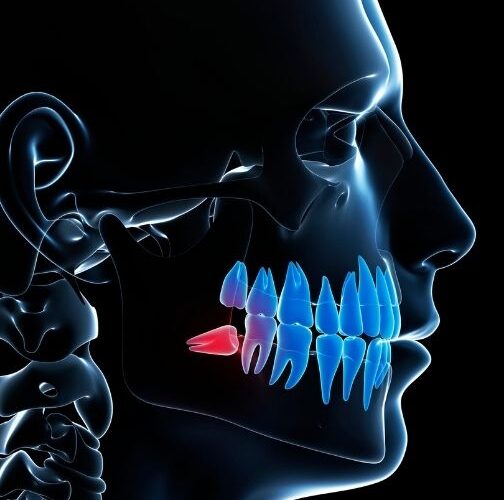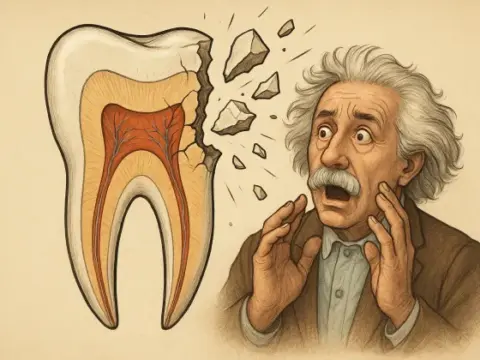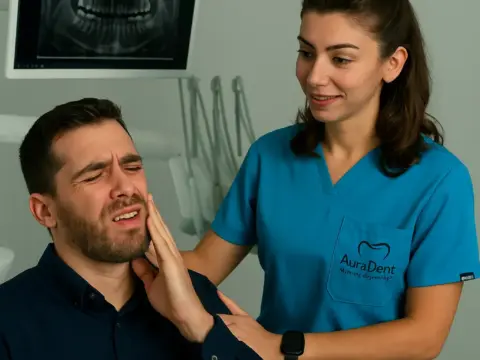Wisdom Tooth Extraction
Don't let wisdom tooth pain become your nightmare; safe treatment with AuraDent!
Wisdom teeth are teeth that fail to erupt through the gums and are most commonly seen with third molars, also known as wisdom teeth. Impacted wisdom teeth can cause pain during chewing, swelling, redness, and even infections. Proper evaluation and treatment planning are essential, which require an examination and X-ray imaging by your dentist. If you have any questions or discomfort related to impacted wisdom teeth, contact AuraDent Aesthetic Clinic to find a healthy solution!


What is an Impacted Tooth?
An impacted tooth is a tooth that fails to erupt through the gums. There are various reasons why a tooth may not erupt. This condition can occur with any tooth but is most commonly seen in wisdom teeth. Wisdom teeth begin to erupt around the age of 17 and are located at the very back of the mouth. If they erupt properly and in alignment, they generally do not cause any problems, and extraction is not required. A detailed examination with an X-ray is essential for an accurate decision. Sometimes, wisdom teeth may only partially erupt, with part of the tooth under the gums and part exposed, which can lead to cavities, gum disease, and infections.
What Are the Types of Impacted Teeth?
The type of impacted tooth depends on its position. Identifying the type of impacted tooth helps determine the most appropriate treatment for the patient. The four most common types of impacted teeth are as follows:
Horizontally Impacted Tooth
Horizontally impacted teeth fail to erupt and are positioned horizontally under the gums. They press against neighboring teeth, causing crowding and, as a result, severe pain.
Vertically Impacted Tooth
In this type of impacted tooth, the tooth is positioned correctly to erupt through the gums. Since it does not press against other teeth, it does not cause crowding. Vertically impacted teeth are not extracted unless they cause problems.
Mesially Impacted Tooth
"Mesial" means "towards the front." Mesially impacted teeth occur when wisdom teeth angle forward towards the front of the mouth. This is one of the most common types of impacted teeth.
Distally Impacted Tooth
"Distal" is the opposite of mesial. Distally impacted teeth are angled towards the throat.
What Are the Symptoms of an Impacted Tooth?
Impacted teeth are common in children when milk teeth are replaced by permanent teeth that remain impacted. In adults, this condition frequently occurs with improperly positioned wisdom teeth. In some patients, symptoms gradually increase, while in others, they appear suddenly.
Impacted teeth may occasionally affect chewing function. If there is insufficient space in the mouth and the tooth remains partially impacted, it can cause pain and discomfort.
Impacted teeth commonly cause redness, pain, and swelling. As the tooth tries to emerge, it can lead to redness and swelling in the surrounding area, and even bleeding in the gums.
One of the symptoms of impacted teeth is bad breath. The improper positioning of the impacted tooth creates an environment for bacteria to thrive, which can lead to gum problems and tooth decay.
Symptoms of Partially Impacted Teeth
- Occasional difficulty opening the mouth
- Persistent headaches and jaw pain
- A visible gap where the tooth should erupt
- Pain or tenderness in the gums and jawbone
- An unpleasant taste when biting in the affected area
- Rarely, swollen lymph nodes in the neck
What Are the Causes of Impacted Teeth?
Impacted teeth occur due to insufficient space in the jaw or improper positioning of the tooth. Genetic factors, jaw structure, and tooth alignment are the primary causes of this condition.



